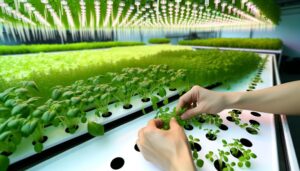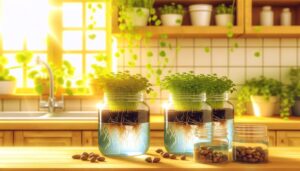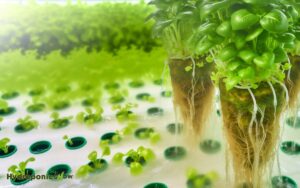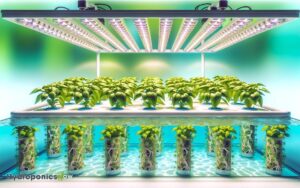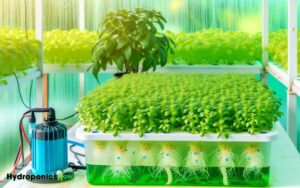3 Do’s and Don’ts to Prevent Hydroponic Plants from Drowning
To guarantee hydroponic plants from drowning, maintain proper oxygenation using air pumps and stones to sustain dissolved oxygen levels at 6-8 ppm.
Choose substrates like coconut coir or clay pellets for balanced aeration and drainage. Carefully monitor water levels and avoid overfilling the reservoir.
Overcrowding plants can deplete oxygen, so provide adequate spacing. Stagnant water should always be avoided as it leads to root rot and nutrient imbalances.
Regularly inspect and clean your system to safeguard root health. By mastering these details, you’ll assure robust plant growth and minimize risks of drowning. More insights await you.
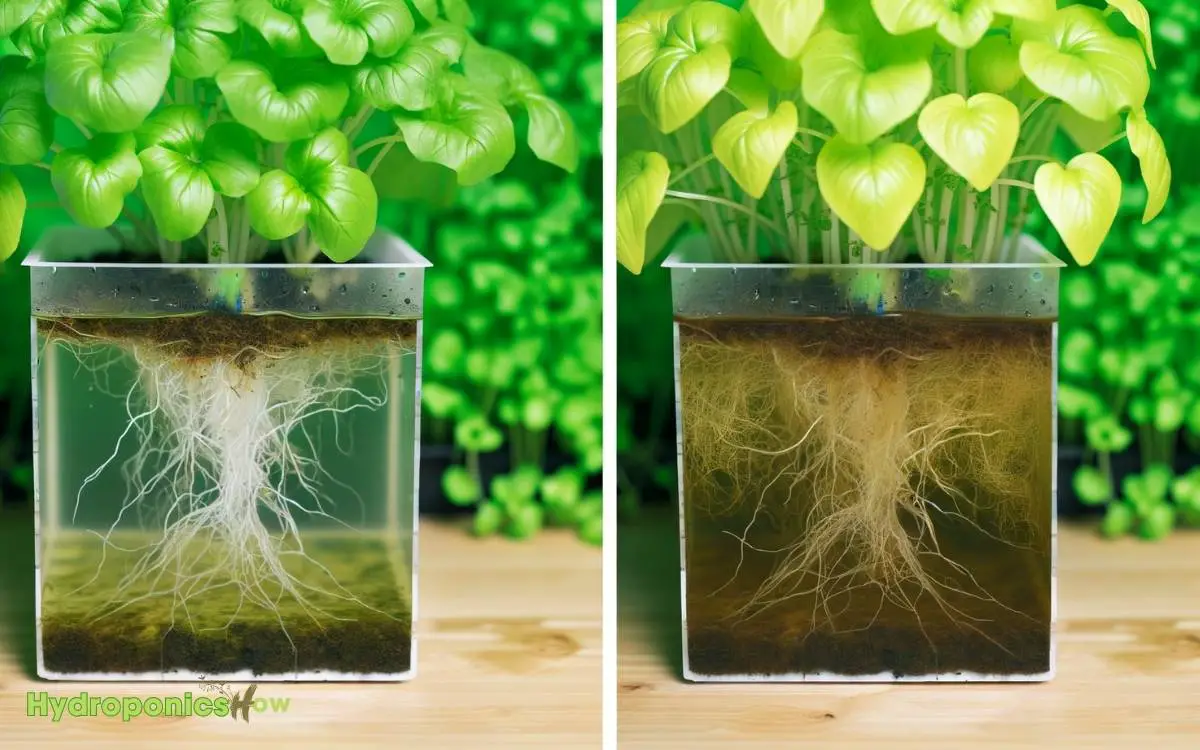
Key Takeaways
Understand Hydroponic Systems
To effectively prevent hydroponic plants from drowning, you must first understand the different types of hydroponic systems and their specific requirements. Some systems, like deep water culture, require constant aeration to keep roots oxygenated, while others, such as nutrient film technique, rely on a continuous flow of nutrient solution. Monitoring water levels, oxygenation, and root health is crucial to preventing issues like root rot. Additionally, keeping an eye on environmental factors, including the potential interactions between cats and hydroponic plants, can help maintain a thriving indoor garden.
Hydroponic systems, such as Deep Water Culture (DWC), Nutrient Film Technique (NFT), and Aeroponics, each have unique oxygenation needs.
DWC submerges roots in nutrient-rich water; you’ll need efficient aeration to prevent oxygen depletion.
NFT uses a thin film of nutrients over the roots, requiring a steady flow to avoid root saturation.
Aeroponics suspends roots in air, misting them with nutrients, needing precise timing to maintain moisture balance without oversaturation.
Understanding these systems ensures you can tailor oxygen delivery, using air pumps, timers, and flow controls, preventing drowning by maintaining ideal root oxygenation and nutrient uptake.
Choose the Right Medium
When selecting a medium for your hydroponic system, you need to focus on achieving ideal water retention, aeration, and drainage.
Research indicates that substrates like coconut coir and perlite offer excellent balance, guaranteeing roots receive sufficient oxygen while preventing waterlogging.
Properly managing these factors is crucial to avoid plant stress and ensure strong growth.
Optimal Water Retention
Selecting a suitable growing medium is essential for ensuring optimal water retention in hydroponic systems. You’ll want to choose a medium that maintains moisture without becoming waterlogged.
Here are three options to explore:
- Coco Coir: Made from coconut husks, coco coir retains water well and provides excellent root support. It also has antifungal properties, reducing disease risks.
- Rockwool: This mineral-based medium has high water retention capacity and provides a stable pH environment, essential for nutrient uptake.
- Clay Pellets: Also known as hydroton, these expanded clay pellets offer good water retention while allowing excess water to drain away, preventing root rot.
Selecting the right medium ensures your plants receive consistent moisture levels, essential for their growth and health.
Aeration and Drainage
Securing proper aeration and drainage in your hydroponic system is crucial for preventing waterlogging and promoting healthy root development.
Choosing the right growing medium is key. Utilize materials like perlite, coconut coir, or expanded clay pellets to facilitate ideal air exchange and drainage.
Perlite offers excellent aeration due to its porous nature, while coconut coir retains moisture but drains efficiently, preventing root rot.
Expanded clay pellets provide sturdy support and maintain consistent oxygen levels around the roots. Studies suggest that combining different mediums can improve overall system performance.
Avoid dense, compacted substrates that restrict airflow and retain excess water. Regularly monitor and adjust your medium to ensure it remains conducive to root health, thereby optimizing plant growth and preventing potential drowning.
Maintain Proper Water Levels
You must maintain proper water levels to prevent hydroponic plants from drowning.
Overwatering can lead to root rot, while inadequate drainage disrupts oxygen availability.
Consistently monitor water quality to avoid nutrient imbalances and harmful pathogens.
Avoid Overwatering Risks
Maintaining the accurate water levels in your hydroponic system is essential to prevent the roots from suffocating and promote peak plant health.
Overwatering poses significant risks, including root rot and reduced oxygen availability. You need to monitor and adjust water levels meticulously.
Here are three research-based steps to avoid overwatering:
- Measure Water Depth Regularly: Use a reliable water level indicator to track daily fluctuations and maintain the ideal depth.
- Employ Aeration Techniques: Integrate air stones or diffusers to guarantee dissolved oxygen levels remain sufficient, enhancing root respiration.
- Monitor Root Health: Inspect roots for signs of overwatering, such as browning or mushiness, and adjust water levels promptly.
Following these steps will help you maintain a balanced hydroponic environment.
Ensure Adequate Drainage
Proper drainage in your hydroponic system is crucial to prevent waterlogging and promote ideal root oxygenation. When roots are submerged for too long, they suffer from hypoxia, leading to stunted growth or plant death.
To guarantee adequate drainage, use well-aerated grow media like perlite or coco coir, which facilitate moisture control. Implement a flood-and-drain (ebb and flow) system to precisely manage water levels, allowing roots to access both nutrients and air.
Regularly check and adjust your system’s drainage components, like pumps and timers, to prevent failures. Studies indicate that maintaining a balance between wet and dry periods enhances root health, enabling efficient nutrient uptake and robust plant development.
Always prioritize drainage to sustain your hydroponic garden’s vitality.
Monitor Water Quality
A hydroponic system’s success hinges on careful monitoring of water quality and maintaining appropriate water levels to guarantee peak plant health.
You need to make sure that the pH levels, nutrient concentration, and water temperature are consistently within ideal ranges for your specific plants.
- Check pH levels daily: Aim for a pH of 5.5 to 6.5, as nutrient absorption depends on it.
- Monitor electrical conductivity (EC): This measures the nutrient concentration. Keep it within the recommended range for your plants.
- Maintain water temperature: Ideal temperatures range from 65°F to 75°F to prevent root diseases and promote nutrient uptake.
Ensure Adequate Oxygenation
Ensuring sufficient oxygenation in hydroponic systems is crucial to prevent root suffocation and promote healthy plant growth. You should use air pumps and air stones to introduce dissolved oxygen into the nutrient solution.
Studies show that oxygen levels around 6-8 ppm (parts per million) are ideal for root respiration. Without adequate oxygen, roots can become waterlogged, leading to root rot and decreased nutrient uptake.
Regularly check dissolved oxygen levels using a digital meter to maintain ideal conditions. Additionally, consider using oxygenating additives like hydrogen peroxide at low concentrations to boost oxygen levels.
Monitor Root Health
Regularly inspect root systems for signs of discoloration, sliminess, or odor, as these are early indicators of potential diseases or nutrient imbalances. Healthy roots should be white or light tan, firm, and odorless.
To guarantee root health, follow these steps:
- Check pH Levels: Maintain a pH range of 5.5-6.5. Deviations can hinder nutrient absorption, leading to root issues.
- Ensure Adequate Oxygenation: Roots need oxygen to thrive. Use air stones or diffusers to keep dissolved oxygen levels high.
- Monitor Water Temperature: Keep water temperature between 65-75°F (18-24°C). Higher temperatures can cause root rot and promote harmful bacteria.
Avoid Overwatering Mistakes
To maintain healthy root systems, it’s crucial to avoid overwatering mistakes that can suffocate roots and lead to plant drowning.
In hydroponic systems, make sure your nutrient solution’s oxygen levels are at their best. Use an air pump and air stones to aerate the water, preventing oxygen depletion.
Monitor water levels consistently; too much water can reduce root oxygenation. Implement a timed watering schedule, adjusting based on plant growth stages and environmental conditions.
Excessive moisture can cause root rot, evidenced by brown, mushy roots. Always check for proper drainage in your hydroponic setup. Research indicates that maintaining dissolved oxygen levels between 5-8 ppm is ideal.
Conclusion
By following these guidelines, you’ll guarantee the success of your hydroponic system.
For instance, in a 2020 study, researchers found that adding an air stone greatly improved oxygenation, reducing root rot incidents by 35%.
By maintaining proper water levels and avoiding overwatering, you can prevent your plants from drowning, thereby ensuring healthy growth.
Remember, consistent monitoring and adjustments are key to thriving hydroponic gardens.
So, immerse yourself and enjoy the fruits of your labor!

